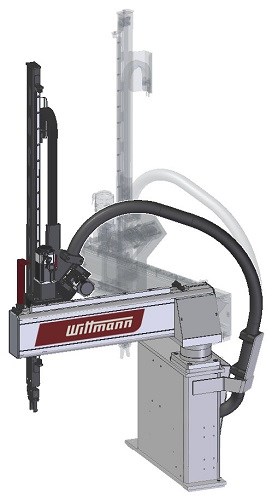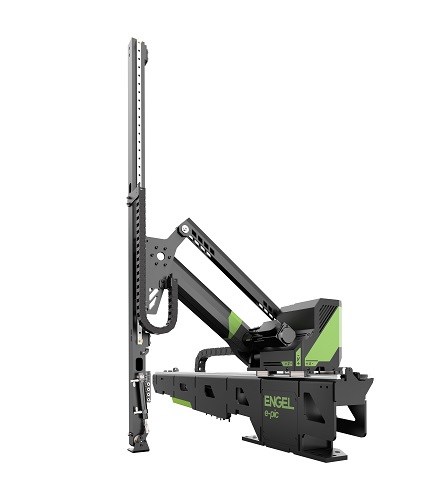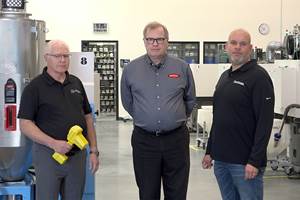Three Themes at Fakuma Show
Servo hydraulics are becoming standard; servo pickers proliferate; water flow monitoring and control are new focus.

Some people call it the “mini K show.” The Fakuma exhibition in Friedrichshafen, Germany, used to be considered a local plastics trade fair for Germany machinery exhibitors to reach an audience in southern Germany, Austria, Switzerland, and the Czech Republic. But the show has grown continuously in importance, and Fakuma 2014 attracted nearly 46,000 visitors from 117 countries and 1772 exhibitors from 36 nations. It was my first time at Fakuma, where the press corps included editors from as far away as Hong Kong and Singapore.
It’s still predominantly an injection molding show, and that’s what I’ll focus on here. Among the new products introduced at Fakuma, three categories stood out because they were highlighted by multiple exhibitors. (In my ┤¾¤¾┤½├¢, if we see something three or more times, we’re tempted to call it a trend.)
1. Servo-hydraulics are the new standard. If you ask me, the future of hydraulics in injection molding—and I do think it has a future for a long while to come—is using pumps with variable-speed servo or frequency drives. When I offered that prediction, officials from Arburg agreed that “there is a clear trend toward servo hydraulics for energy savings and noise reduction.” Confirming that trend, several machine builders introduced presses with servo hydraulics standard instead of an option that used to cost around 10% additional but provided energy savings nearly equivalent to those of an all-electric machine. Examples:
• (U.S. office in Torrington, Conn.) introduced the SmartPower series that will replace the conventional hydraulic HM series in sizes from 25 to 120 metric tons at no extra cost. They reportedly cost about 20% less than an all-electric for equivalent energy consumption.
• (U.S. office in Strongsville, Ohio) brought out the System Servo series. They do cost a bit more than standard Systec models, but Sumitomo says 60-70% of those machines are being sold with servo pumps anyway.
• (U.S. office in Florence, Ky.) has revised and upgraded its CX Series in smaller sizes (35 to 160 m.t.) with servohydraulics now standard. A company official said, candidly, that there is no increase in list price, but discounts might be less than before.
• of China (U.S. representative is Absolute Haitian in Worcester, Mass.) has new smaller models of its servo-hydraulic, two-platen Jupiter II series, starting at 450 m.t.
• Engel (U.S. office in York, Pa.) still offers servo hydraulics as an option, but it’s one that 70% of its hydraulic machine customers purchase.
• (U.S. office in Exton, Pa.) already makes servo hydraulics standard on all its machines except its very smallest XS model (10 m.t.). Boy sees no further advantage in—and therefore does not offer—all-electrics.


2. Sprue pickers go servo. Servo-powered sprue pickers were a hot button at Fakuma, promising more speed and precision than pneumatics with lower energy consumption.
• introduced the WS80 servo picker with a rotary axis and two linear axes. It’s designed to operate within the machine guards.
• showed off its new SPX10 servo picker, also with a rotary axis and telescoping vertical arm. It operates within the machine envelope.
• Engelintroduced the servo-driven e-pic, which is distinctive for its horizontal traverse and toggle-type articulated vertical arm (similar to some Japanese designs I’ve seen) and a further telescoping action.
• While not new, (U.S. office in Newington, Conn.,) showed its two-year-old swiveling servo picker.
• (U.S. office in Pittsburgh) showed its S3 swiveling servo picker, which also appeared at Fakuma 2013 and K 2013.
• operated its year-old swiveling sprue picker—a pneumatic model.
3. Mold cooling gets more attention. Injection machine suppliers are now addressing mold cooling as a process variable that has received far less attention than other sources of quality and productivity fluctuations.
• Engelintroduced the e-flomo water manifold that automatically monitors water pressure and temperature and adjusts water-flow valves to compensate for filter clogging and system pressure variations.
• showed its new ultrasonic flow monitor for Tempro plus D series TCUs that now operates at higher temperatures (160-180 C) and measures flow rates down to 0.5 liter/min with ± 5% accuracy. Also new is the Flowcon plus water regulator, which controls either temperature or flow rate for each individual water circuit. It’s aimed particularly at non-heated water (up to 100 C) and measures flow in a noncontact manner from 1 to 15 l/min. Wittmann says more than half of its mold-temperature controllers are now sold with a flow-regulation device.
• operated an all-electric AX machine with a flow-monitoring system integrated into the MC6 machine controller to document the mold heat balancing for quality records.
Related Content
Conair Names New Head of Customer Care
Jared Helfrich to direct the efforts of the machine builder’s growing customer care group, combining its existing parts and service and repair organization with a new range of fast-growing customer services.
Read MoreChiller Lines Updated to EPA-Approved Refrigerants
Thermal Care’s chillers now utilize EPA-approved low Global Warming Potential (GWP) RÔÇÉ454B and RÔÇÉ513A refrigerants.
Read MoreCaptive Molder Beefs Up Auxiliaries to Boost Quality, Consistency
SeeScan adds conveying, drying, feeding and chilling technologies to improve quality — and enhance employee safety — in production of its underground/underwater inspection systems.
Read MoreIndustry Vet Duff Joins ACS Group
With 37 years of experience on both machinery and processor side, Michael Duff to handle aftermarket ┤¾¤¾┤½├¢ for auxiliary equipment manufacturer.
Read MoreRead Next
People 4.0 – How to Get Buy-In from Your Staff for Industry 4.0 Systems
Implementing a production monitoring system as the foundation of a ‘smart factory’ is about integrating people with new technology as much as it is about integrating machines and computers. Here are tips from a company that has gone through the process.
Read MoreFor PLASTICS' CEO Seaholm, NPE to Shine Light on Sustainability Successes
With advocacy, communication and sustainability as three main pillars, Seaholm leads a trade association to NPE that ‘is more active today than we have ever been.’
Read MoreBeyond Prototypes: 8 Ways the Plastics Industry Is Using 3D Printing
Plastics processors are finding applications for 3D printing around the plant and across the supply chain. Here are 8 examples to look for at NPE2024.
Read More













